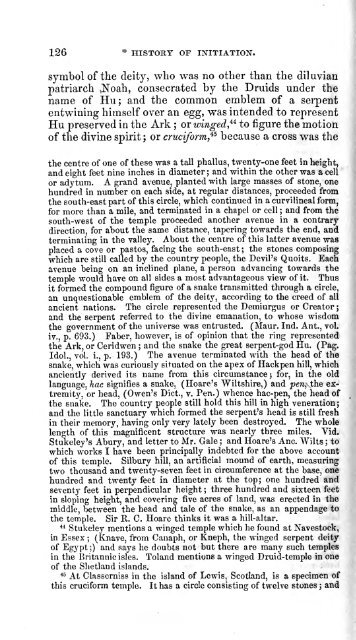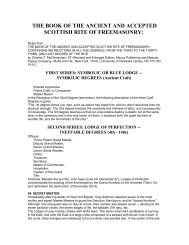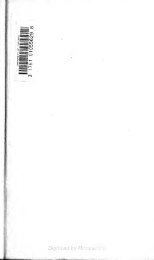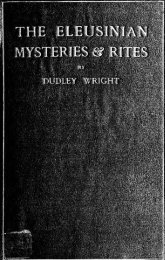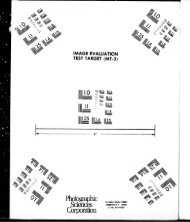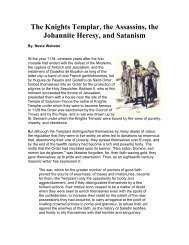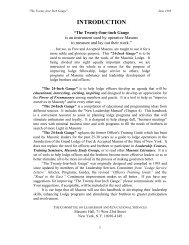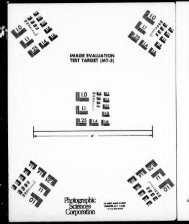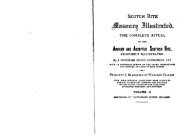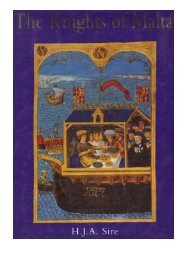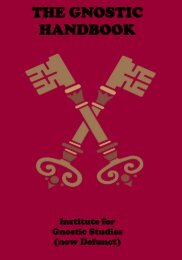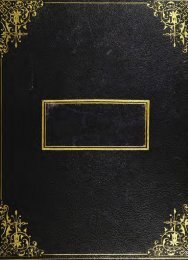The History of Initiation - The Masonic Trowel
The History of Initiation - The Masonic Trowel
The History of Initiation - The Masonic Trowel
You also want an ePaper? Increase the reach of your titles
YUMPU automatically turns print PDFs into web optimized ePapers that Google loves.
126<br />
* HISTORY OF INITIATION.<br />
symbol <strong>of</strong> the deity, who was no other than the diluvian<br />
patriarch ,Noah, consecrated by the Druids under the<br />
name <strong>of</strong> Hu; and the common emblem <strong>of</strong> a serpent<br />
entwining himself over an egg, was intended to represent<br />
Hu preserved in the Ark ; or winged, 44 to figure the motion<br />
<strong>of</strong> the divine spirit ; or cruciform, 45 because a cross was the<br />
the centre <strong>of</strong> one <strong>of</strong> these was a tall phallus, twenty-one feet in height,<br />
and eight feet nine inches in diameter; and within the other was a cell<br />
or adytum. A grand avenue, planted with large masses <strong>of</strong> stone, one<br />
hundred in number on each side, at regular distances, proceeded from<br />
the south-east part <strong>of</strong> this circle, which continued in a curvilineal form,<br />
for more than a mile, and terminated in a chapel or cell ; and from the<br />
south-west <strong>of</strong> the temple proceeded another avenue in a contrary<br />
direction, for about the same distance, tapering towards the end, and<br />
terminating in the valley. About the centre <strong>of</strong> this latter avenue was<br />
placed a cove or pastos, facing the south-east the stones ; composing<br />
which are still called by the country people, the Devil's Quoits. Each<br />
avenue being on an inclined plane, a person advancing towards the<br />
temple would have on all sides a most advantageous view <strong>of</strong> it. Thus<br />
it formed the compound figure <strong>of</strong> a snake transmitted through a circle,<br />
an unquestionable emblem <strong>of</strong> the deity, according to the creed <strong>of</strong> all<br />
ancient nations. <strong>The</strong> circle represented the Demiurgus or Creator ;<br />
and the serpent referred to the divine emanation, to whose wisdom<br />
the government <strong>of</strong> the universe was entrusted. (Maur. Ind. Ant., vol.<br />
iv., p. 693.) Faber, however, is <strong>of</strong> opinion that the ring represented<br />
the Ark, or Ceridwen and the snake the ; great serpent-god Hu. (Pag.<br />
Idol., vol. i., p. 193.) <strong>The</strong> avenue terminated with the head <strong>of</strong> the<br />
snake, which was curiously situated on the apex <strong>of</strong> Hackpen hill, which<br />
anciently derived its name from this circumstance; for,<br />
in the old<br />
language, hac signifies a snake. (Hoare's Wiltshire,) and pen, the extremity,<br />
or head, (Owen's Diet., v. Pen.) whence hac-pen, the head <strong>of</strong><br />
the snake. <strong>The</strong> country people still hold this hill in high veneration ;<br />
and the little sanctuary which formed the serpent's head is still fresh<br />
in their memory, having only very lately been destroyed. <strong>The</strong> whole<br />
length <strong>of</strong> this magnificent structure was nearly three miles. Vid.<br />
Stukeley's Abury, and letter to Mr. Gale ; and Hoare's Anc. Wilts ; to<br />
which works I have been principally indebted for the above account<br />
<strong>of</strong> this temple. Silbury hill, an artificial mound <strong>of</strong> earth, measuring<br />
two thousand and twenty-seven feet in circumference at the base, one<br />
hundred and twenty feet in diameter at the top; one hundred and<br />
seventy feet in perpendicular height ; three hundred and sixteen feet<br />
in sloping height, and covering five acres <strong>of</strong> land, was erected in the<br />
middle, between the head and tale <strong>of</strong> the snake, as an appendage to<br />
the temple. Sir R. C. Hoare thinks it was a hill-altar.<br />
44<br />
Stukeley mentions a winged temple which he found at Navestock,<br />
in Essex ; (Knave, from Canaph, or Kneph, the winged serpent deity<br />
<strong>of</strong> Egypt;) and says he doubts not but there are many such temples<br />
in the Britannic isles. Toland mentions a winged Druid-temple in one<br />
<strong>of</strong> the Shetland islands.<br />
45 At Classcrmss in the island <strong>of</strong> Lewis, Scotland, is a specimen <strong>of</strong><br />
this cruciform temple. It has a circle consisting <strong>of</strong> twelve stones and<br />
;


